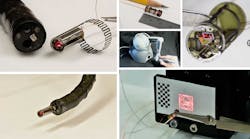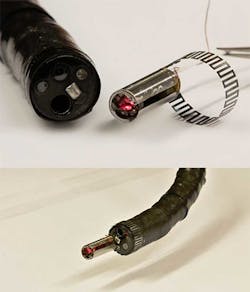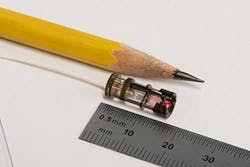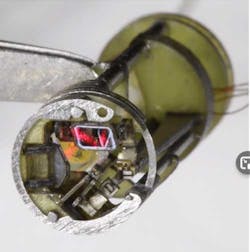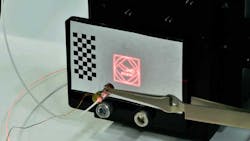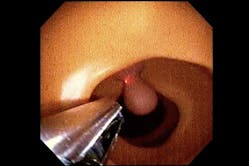Doctors insert an endoscope with an emergent laser beam at its head end into the gastrointestinal (GI) tract to inspect and even perform microsurgery such as treating and excising lesions. They control the laser beam of this minimally invasive surgical tool using one of two different approaches: via robotic-arm fiber steering or optical steering. In fiber steering, magnets and electromagnetic coils, or even cables or push-pull rods, physically bend the tip of the optical fiber. In optical steering, the fiber isn’t bent; rather, mirrors or prisms direct the laser beam after it emerges from the end of the fiber.
The magnet/coil approach is flexible and can access hard-to-reach areas, but it’s relatively slow and thus causes thermal damage to sensitive tissue due to carbonization. In contrast, the optical approach is fast and minimizes tissue damage, but has undesired bulk, can only function “line of sight,” and is unable to reach into hidden crevices.
Now, a research team at Harvard University’s Wyss Institute for Biologically Inspired Engineering and the Harvard Microrobotics Lab (in the School of Engineering and Applied Science, or SEAS) has devised a microrobotic endoscope with a laser beam that can be steered via an external joystick over a large range at high speed and with great precision (Fig. 1). They anticipate that this development, if verified by further tests of its “real world” performance, could help significantly improve the performance of minimally invasive surgeries.
The device, which is just 6 mm in diameter and 16 mm in length, contains two mirrors controlled by piezoelectric actuators that direct the laser’s position (Fig. 2) in a complex opto-electromechanical device. It’s possible to integrate the device with existing surgical tools to control the position of a fiber-delivered laser.
To ensure that an adequate range of motion can be developed within such a small device, the team used miniature, compliant mechanisms to convert the linear motion of the actuators into the rotational motion of integrated mirrors. Further, to focus and position the laser beam, the compact “teleoperated” device uses two independent, orthogonal mirrors driven by piezoelectric bending actuators to rotate with the help of flexure-based linkages, and off-the-shelf optical components to focus a fiber-coupled laser beam (Fig. 3).
To assemble the device, the team needed to develop a new modular assembly technique that will streamline the assembly process for future versions. They achieved steering of a fiber-delivered laser beam at high speed (1.2-kHz bandwidth) over a large range (over ±10 degrees in both x and y axes) with excellent static repeatability (better than 200 µm).
Graduate student and lead researcher Dan York said, “These compliant mechanisms are built using printed-circuit MEMS, which allow them to be built very compactly. It is the same fabrication technology that the Microrobotics Lab at Harvard has used for other advances… an alternative to our approach would be, for example, to use miniature electric motors, but these simply aren’t made small enough to be suitably miniaturized for these applications.”
The researchers have shown that their laser-steering device can map out and follow complex trajectories as directed by a manual controller (Fig. 4) at high speed over a large range, and repeat this motion with high accuracy (Fig. 5).
Such outside-the-body tests are useful and necessary but do not demonstrate performance in the much-more-challenging in-body GI setting. To do so, they also attached the device onto the end of a colonoscope and used it to target and practice on simulated lesions in an artificial colon model (Fig. 6).
It’s interesting to note that the project was initially conceived of as a way to leverage the design of a similar device already in use in different medical settings. The team looked at how lasers are used for vocal-fold polyp resections (transoral laser microsurgery), where the laser’s precision allows surgeons to make very fine dissections to retain healthy tissue and recover voice function.
However, for that procedure, the laser is controlled by mirrors outside the patient’s body and aimed through their airway down to the vocal folds, which is a different scenario than GI tract endoscopy. Therefore, the challenge of this project was to miniaturize the laser-steering mechanical while adding more encapsulation and ruggedness.
The project is described in their paper “Microrobotic laser steering for minimally invasive surgery” published in Science Robotics. In addition, here's an excellent three-minute video:
The team is looking to next validate the system in actual clinical settings while also addressing the additional challenges of ensuring the device’s robustness in what York describes as the “tricky, constrained environments” found inside the human body. “For example, the system must be robust to external forces, vibrations, and fluids. This requires encapsulation and additional validation,” he added.
